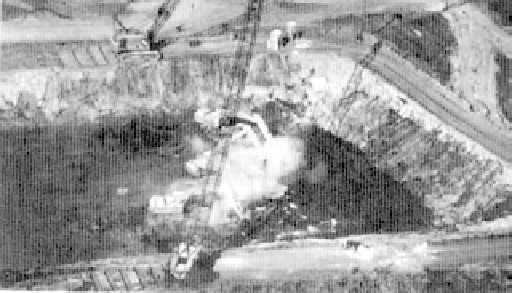Environmental Engineering Reference
In-Depth Information
is transported from the ash collection system on a conveyor belt, and little additional
mechanical equipment is required. This results in a simple, inexpensive stabilization
of soluble metals (e.g., lead) in the ash. Spraying with a cement slurry is also used,
with or without additional reagents.
13.3.1.2
In Situ
Methods
In situ
methods were probably the first to be used for non-nuclear remedial projects,
long before RCRA, the Land Disposal Restrictions Program, Superfund, and the
other legislative and regulatory tools that created a hazardous waste industry. In
those days, S/S was used primarily for solidification of liquid and semi-liquid wastes
in ponds or “lagoons” so that those collection systems could be reused, or the land
area used for another purpose such as construction. Backhoes were always available,
and solidification with cement, lime, flyash, or other inexpensive binders was easy
and inexpensive. Such simple systems are still used for that purpose. However, much
remediation work now requires a more sophisticated approach, and
in situ
technology
has had to keep pace with the changes.
In addition to just S/S processing, both
ex situ
and
in situ
methods are capable
of conducting sequential treatment operations; for example, pre-treatment to oxidize
or reduce a constituent followed by solidification. However, containment between
the operations is easier with
in situ
processing, and waste handling is essentially
eliminated. Stripping volatile organics from contaminated media prior to metal
stabilization is one multi-method operation especially amenable to
in situ
treatment.
With
ex situ
treatment, two different treatment systems must be mobilized to the
site and operated; with
in situ
treatment, the same basic equipment often does both
more cost-effectively.
Backhoe-Based Methods.
The first such implement used for
in situ
treatment
was the familiar backhoe. Figure 13.2 shows this operation at a large remedial
operation, where several backhoes are in use at one time. Reagents were poured on
the surface of the area to be treated and mixed to the required depth with the backhoe,
or tilled in with a harrow for treatment of shallow layers. This, obviously, was not
FIGURE 13.2
In situ
mixing with backhoes.

Search WWH ::

Custom Search